Restoring Blowout Penstemon (Penstemon haydenii) in Nebraska
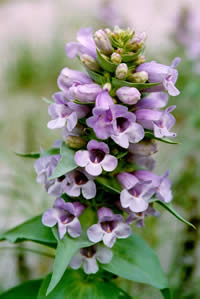 Blowout penstemon close-up. Photo by Tim Griffin, U.S. Forest Service.
Blowout penstemon close-up. Photo by Tim Griffin, U.S. Forest Service.
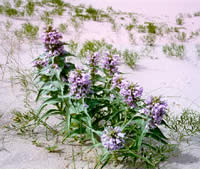 Mature blowout penstemon plants can be about two feet tall. Photo by Tim Griffin, U.S. Forest Service.
Mature blowout penstemon plants can be about two feet tall. Photo by Tim Griffin, U.S. Forest Service.
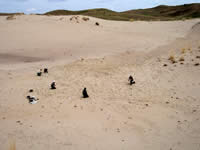 Planting blowout penstemon on the Bessey Ranger District. Photo by Tim Griffin, U.S. Forest Service.
Planting blowout penstemon on the Bessey Ranger District. Photo by Tim Griffin, U.S. Forest Service.
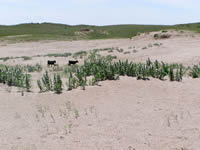 Livestock grazing can be used to help maintain the habitat for blowout penstemon. Photo by Rick Arnold, U.S. Forest Service.
Livestock grazing can be used to help maintain the habitat for blowout penstemon. Photo by Rick Arnold, U.S. Forest Service.
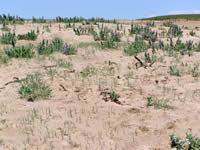 Successful reintroduction of blowout penstemon to the Nebraska sandhills. Photo by Rick Arnold, U.S. Forest Service.
Successful reintroduction of blowout penstemon to the Nebraska sandhills. Photo by Rick Arnold, U.S. Forest Service.
by Tim Griffin, Bessey Ranger District, U.S. Forest Service
Blowout penstemon, also known as Hayden’s penstemon or blowout beardtongue (Penstemon haydenii) is a short-lived perennial forb found only in north central Nebraska and northeast Great Divide Basin in Wyoming. Habitat for this species in Nebraska is described as bare sand in the bowl of blowouts or in conjunction with blowout grass (Redfieldia flexuosa) in deposition areas around a blowout and at an elevation of approximately 2,800 feet. First described in 1857 by Ferdinand V. Hayden, blowout penstemon was listed as endangered by the U.S. Fish and Wildlife Service in 1987 and is the only federally endangered plant species in Nebraska.
The sandhills of Nebraska are the largest grass-stabilized dune field in North America, covering an area of approximately 19,300 square miles. A majority of the region is in a relatively natural grass covered condition. Blowout penstemon was probably widely scattered across the landscape in the past, but is now restricted to blowouts. Blowouts are areas of disturbance where the vegetative cover has been removed and wind erosion has cut the dune forming craters and trenches, with the sand having been deposited on the down wind side. Historically, repeated fires and concentrations of grazing animals provided the disturbances necessary to create and maintain active blowouts suitable for establishment of blowout penstemon.
On May 22, 2000 personnel from the U.S. Forest Service and University of Nebraska, in Lincoln, planted 1,000 seedlings (produced in the University greenhouses) into suitable areas on the Bessey Ranger District, which includes the Nebraska and Samuel R. McKelvie National Forests. Eight blowouts were planted; however, the penstemon failed to become established in two of these areas. Subsequent plantings have been completed using seedlings grown in the greenhouses at the Bessey Nursery from seeds collected on the District. Currently there are seven populations on the District that are monitored each year. Seedlings produced in the Bessey Nursery greenhouses are being used to establish a new population in one of the blowouts which failed previously.
Reduced grazing intensity, implementation of grazing systems by ranchers, and wildfire suppression has resulted in increased plant cover and stabilizing blowouts. The decreased frequency and extent of suitable habitat due to the successful control of unstable sand dunes and blowouts has resulted in the isolation of penstemon populations limiting the dispersal of seed. Moderate disturbance to existing blowouts using livestock to maintain or enhance habitat has been successful. The reintroduction of fire into the system in combination with grazing disturbance is expected to improve the quality and frequency of habitat. Recreational off road vehicle (OHV) use of blowouts, while effective at reactivating blowing sand and maintaining the area as a blowout, is a heavy impact resulting in the elimination of penstemon populations. Concentrated OHV use can be used to create active blowouts for use as reintroduction sites. Protection of blowouts containing populations of blowout penstemon from OHV use is necessary for the existence of viable penstemon populations. The current travel management effort is expected to address this issue on the Bessey Ranger District.
This reintroduction effort has established more blowout penstemon plants on the Bessey Ranger District than exist anywhere else in the world.
Partners
- U.S. Forest Service
- University of Nebraska – Lincoln

